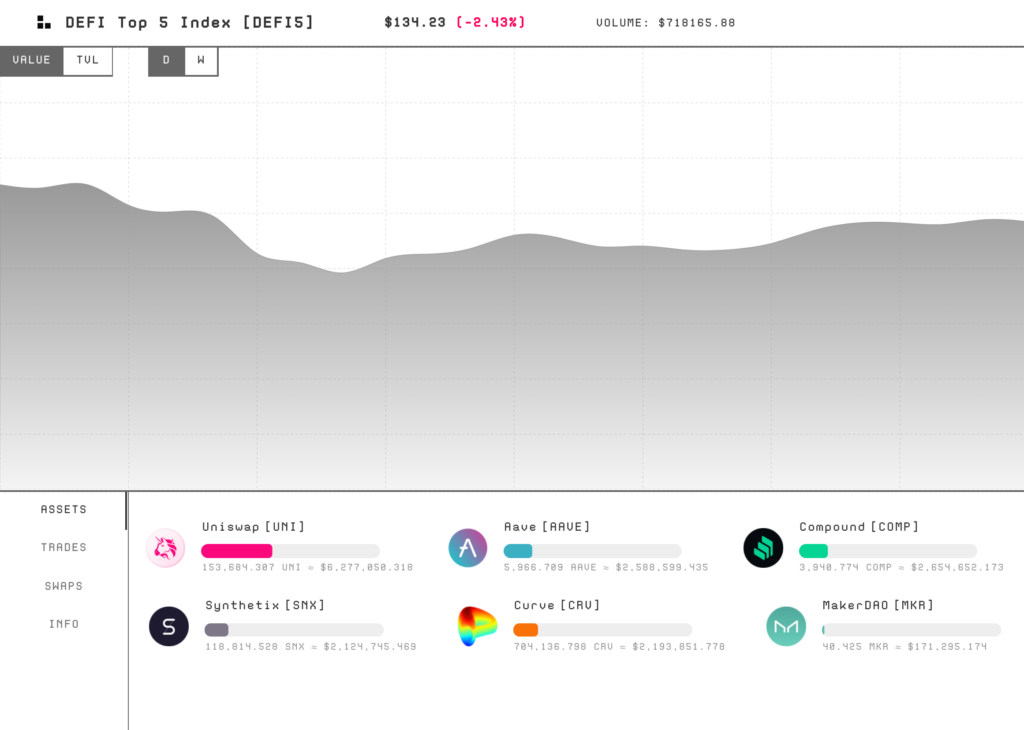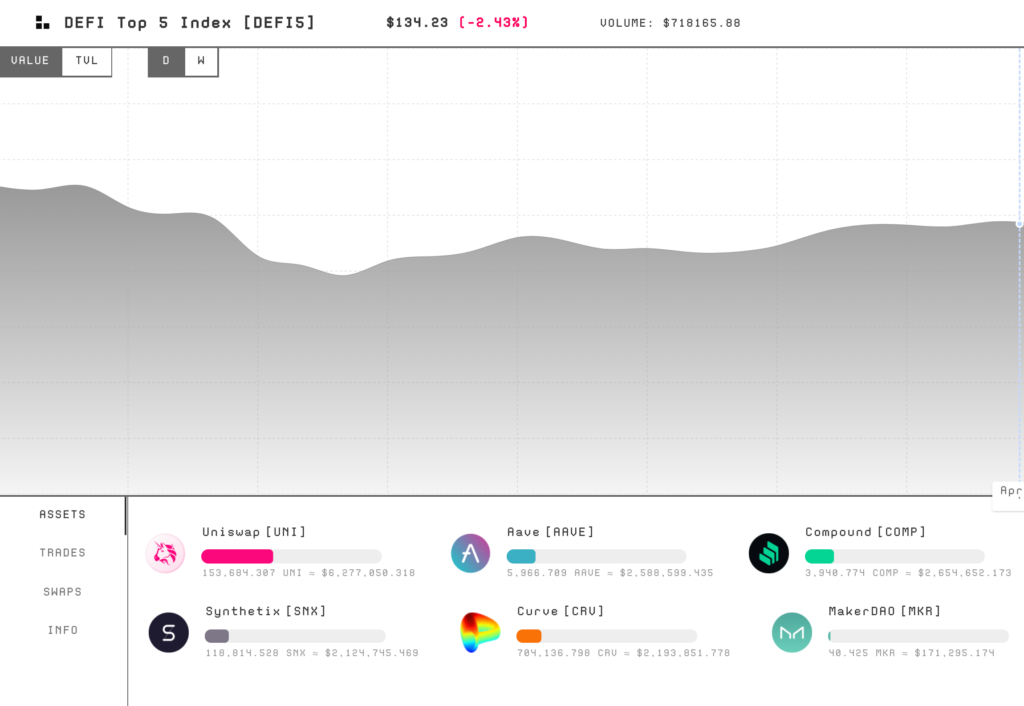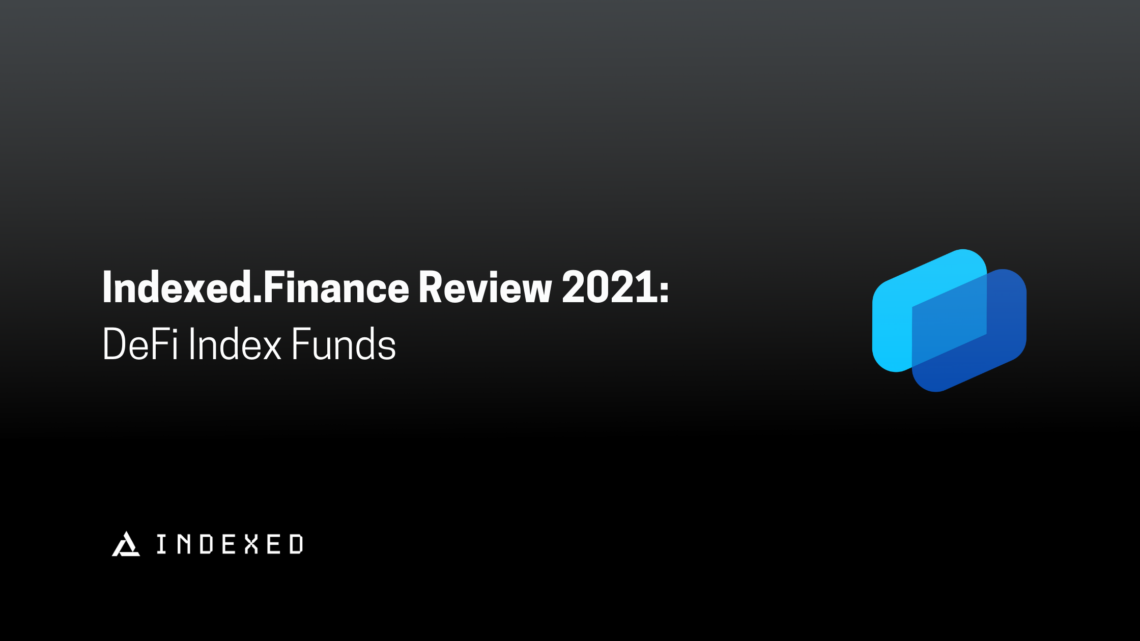By now, everyone knows that for you to increase your personal wealth, you must invest. Fortunately, today, you don’t even need to be a token-picking expert before you can invest in the exponentially developing Decentralized finance (DeFi) space. Simply investing in a DeFi index will automate your entire investment plan for you.
In 1975, Jack Bogle created the index fund, a practical approach for retail investors to compete with professionals. The aim of this innovation is not outperforming the market; rather to keep up with it. Years later, index funds have grown to become very trusted and are gaining traction. According to a recent study, they now comprise approximately half of the 9 trillion USD of total assets held in stock.
What Is an Index Fund?
This is an investment fund established on a preset assets collection. As an alternative to analyzing individual assets and selecting the best performing, an index fund uses your capital to invest in a basket of assets with just one purchase. Usually, index funds outperform asset investors while ensuring the added advantage of reduced transaction fees. Recently, we’ve been experiencing a surge in gas fees on the Ethereum network. Thus, this feature of index funds is even becoming more attractive to several crypto enthusiasts.
In essence, an index fund is a portfolio created to track or match some elements of the financial market sector, like the S&P 500 index. Anytime particular assets rise or dip in value, the asset rebalances and goes back to the percentage allocation aimed for that asset.
This investment model lets investors create a passive portfolio management strategy and relieves them of the stress of managing a successful portfolio. One of the most significant advantages an index has to offer is diversification. Spreading your investments over several assets signifies that there is a lesser risk involved than investing in one.
What Is a Decentralized Index?
For a while now, index funds have been a worthwhile investment in the traditional markets. The same qualities that make them a profitable venture in the traditional market qualify them to be the same in Decentralized Finance as well.
Rather than trying to select a winner token — which is usually tricky to forecast in advance, you can purchase a basket of tokens, which were painstakingly chosen by index methodologists. This presents you with a higher possibility of achieving good returns. Even if a token performs poorly, several other tokens help you maintain the index price.
Perhaps, the most significant distinguishing factor between the traditional and DeFi indices is that rebalancing and re-weighting in the Decentralized indices is automated on-chain with smart contracts.

In the traditional financial space, you get to pay a management fee to managers who manually rebalance and reweighs the stocks held in, for instance, an S&P 500 index. However, all these happen automatically in the Decentralized Index. Besides, governance token holders may also decide on future directions, which may not be possible in the traditional space.
With that said, Index funds are beginning to gain traction in the Decentralized finance (DeFi) space, with multiple projects emerging in that regard. Each project is experimenting with various mechanics. However, the best, judging by various metrics, is still arguably Indexed Finance. Suppose you want to delve into this space of Index investing. Then, in that case, this article is for you as it will cover all you need to know about Index investing and the Indexed Finance project.
Meet Indexed Finance
Unarguably, this is one of the hottest in the DeFi space at the moment. Indexed Finance is a protocol that focuses on passive portfolio management. This signifies that the entire re-weighting and rebalancing of indices takes place automatically via on-chain processes. In this space, it is arguably one of the projects that offer these features in the most Decentralized approach.
You only need governance to vote on decisions like the market sector definitions, indices deployment, and endorsing new management plans. As mentioned before, this is one of the hottest around today. During the first month of its launch, DeFi5 skyrocketed by 450% and CC10 by over 250%. And today, evidently, its indices are the best performing in the space.

Anytime you purchase an index from Indexed Finance, you may stake it to earn the NDX tokens. The annual percentage yield for that hovers around 300%. Audited by some of the most reputable individuals in the market, Mudit Gupta and Daniel Luka, this project passed both audits, making it a trustworthy venture.
Since launch, Indexed Finance has launched 4 more indices giving users exposure to various market sectors. All have performed very well.
– ORCL5: tracking the oracle sector
– NFTP: tracking the NFT and Metaverse sector
– DEGEN: a small-cap high growth index, more risk more reward
– ERROR: an index in cooperation with 0xb1 the largest anonymous investors with over $1billion AUM
The Token: $NDX
NDX token is the governance token for Indexed Finance. It’s primary function is to participate in governance of the protocol. Since Indexed is a decentralized protocol all important parameters and decisions have to be voted on by $NDX holders. . You can vote on various decisions such as the market sector definitions, indices deployment, and general strategic decisions. Besides, Indexed is just about to release a new feature that will bring cash flows to NDX holders by distributing protocol revenues to those who stake. This makes NDX one of the few DeFi tokens that yields dividends.
Leveraging the fact that 2.5% of fees on swaps go to index holders, this governance token to add to or change this to generate more value to its holders. Besides, the NDX governor can also set an exit fee on the current or any future pools to create passive income for the treasury.

Features and Options
- Indexing
The current indexing strategy on this project tracks particular market sectors, initially defined by governance, using some requirements for token eligibility. A controller contract on Indexed Finance stores multiple tokens (up to 25) for each sector. These tokens are managed by governance per the sector’s inclusion criteria.
Periodically, market sector tokens are sorted on-chain using their diluted market caps.
Tokens for these market sectors are sorted periodically on-chain with their fully diluted market caps. Their applications are extrapolated from the moving average price recorded on Uniswap. Anytime the deployment of an index pool occurs, the platform assigns it with target size, e.g 5 for DEFI5 which it uses to choose the top five performing tokens in that sector from the larger list.
On deployment, it then weighs the tokens by the square roots of their market caps. Besides, once every week, it recalculated and assigned these weights as new target weights in the pools. Anytime re-weighting for a particular pool has been done four times, it re-indexes it, which signifies that it may remove the asset and swap it out for the next best on the list.
- Index staking
If you have an Index token, you may decide to participate in the liquidity mining scheme. During this, it distributes 25% of the NDX token supply to Index holders who stake their index tokens. Overall, there are four available pools; CC10 (Simple staking), DEFI5-ETH, CC10-ETH, and CC10.
During the first liquidity mining phase that lasted until March 2021, each pool received a total of 625,000 NDX. Anytime you stake your Index, you may receive a pretty more negligible NDX because more and more users choose this option because they regard it as less risky.
Alternatively, you may also provide liquidity on Uniswap; however, just like many investments, there are some associated risks, such as impermanent loss.

Once you complete all the necessary steps, all you need to do is lean back and watch your NDX tokens skyrocket. As long as you stake your index tokens, you’ll keep earning NDX tokens. Besides, you’re also free to un-stake your NDX tokens or claim your rewards anytime you deem fit.
However, to minimize gas costs, it is usually advisable to claim your NDX tokens once you’ve earned enough amount to make it worthwhile.
- Portfolio structure
Index pools adopt a fork of Balancer, which features modifications that allow gradual reselection and re-weighting of relevant assets. Every token in the pool has a weight. This weight signifies the proportion of the total pool value of that token. You can trade tokens within a pool at prices, which are determined by their balances and weight.
Using an AMM as the liquidity holding mechanism allows your index pools to generate returns, which are behind the growth of underlying tokens anytime the fees resulting from swaps are higher than the impermanent arbitrage loss.
- Rebalancing
Anytime the controller updates a pool’s weight target, the effects are not immediate. In contrast, the actual token weight moves towards their target anytime it executes a swap, with a minimum frequency. Over time, this creates an opportunity for small arbitrage, which as an arbitrageur, you can execute to move these balances towards your targets.
Anytime the platform adds a new token via re-indexing, the pool utilizes price data from Uniswap and its market cap for that token within its AMM. However, whenever the balance reaches 1% of the pool’s value, the price goes back to normal.
Why Indexed Finance?
Now, you understand what Indexed Finance is all about; you are aware of its functionalities and methodology. Yes, this platform is very recommended for investing, but so are several others. However, a few things make it stand out amongst its competitors, which makes it the best DeFi index to try.
On analyzing this project with several criteria such as performance asset selection and fees, it seems that the CC10 and DEF15 from this platform are the best index picks you can find around today. They are the best performing, and on top of that, they are the only indices that do not charge a holder’s management fee.
The DEF15 keeps track of the top 5 assets in the DeFi space, usually referred to as the Blie Chips. On the other hand, the CC10 is a bit faster and oversees and keeps track of five more assets. In essence, they are the best performing you can find around today.

Right now, Indexed Finance does charge any fees. Some of their competitors charge for streaming, which is usually paid yearly on TVL. However, this platform is yet to start charging and may likely avoid charging users directly. At the time of writing this guide, only one Index on Indexed Finance charges an exit fee — the DEGEN index. DEGEN holders who intend to burn their index tokens to redeem them against the ten underlying tokens will pay this fee. Usually, this fee results from arbitrage whenever DEGEN trades at a discount relative to the net value of the ten tokens it signifies. Thus, in this case, a charge is justified.
Getting Started on Indexed Finance
In recent years, we’ve experienced unprecedented and growing demand for governance tokens in the DeFi space. And as such, DeFi indexes offer some of the most cost-effective and efficient avenues for investing in the DeFi ecosystem. As years pass by, expect to see these asset’s popularity and growth skyrocket, especially amongst mainstream newcomers into the blockchain and cryptocurrency space.
Besides, the index token scene is still quite early; hence, although the available products are pretty exciting, we should still expect more to come as the ecosystem leans forward. DeFi indices are phenomenal investment tools that will indeed create immense value while mitigating risks and costs that follow speculating DeFi assets.
With that said, Indexed Finance provides you the opportunity to invest in the various indices seamlessly and earn governance tokens in the most decentralized way. If all these align with your objectives as an investor, you may want to give it a try.
Disclaimer: This article is not intended to be a source of investment, financial, technical, tax, or legal advice. All of this content is for informational purposes only. Readers should do their own research. The Capital is not responsible, directly or indirectly, for any damage or loss caused or alleged to be caused by reliance on any information mentioned in this article.
For publishing articles on our website get in touch with us over email or one of the accounts mentioned below.


 Home
Home News
News










